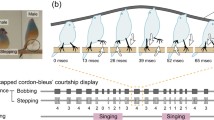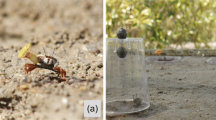Abstract
In the courtship process, multiple signals are often used between the signaller and the receiver. Here we describe female response to multiple male visual morphological and behavioural signals in the swordtail characin, Corynopoma riisei. The swordtail characin is a species in which males display several morphological ornaments as well as a rich courtship repertoire. Our results show that high courtship intensity was associated with an increased female response towards the male ornament, increased number of mating attempts and a reduction in female aggression. The morphological aspects investigated here did not seem to correlate with female response. This may indicate that, when both behaviour and morphology are considered simultaneously, courtship behaviour may have priority over morphological cues in this species.

Similar content being viewed by others
References
Amcoff M, Kolm N (2013) Does female feeding motivation affect the response to a food-mimicking male ornament in the swordtail characin Corynopoma riisei? J Fish Biol 83:343–354
Amcoff M, Kolm N (2014) A test of sensory exploitation in the swordtail characin (Corynopoma riisei) based on colour matching between female prey and male ornament. Environ Biol Fishes 97:247–254
Amcoff M, Arnqvist G, Kolm N (2009) Courtship signalling with a labile bilateral signal: males show their best side. Behav Ecol Sociobiol 63:1717–1725
Amcoff M, Lindqvist C, Kolm N (2013) Sensory exploitation and plasticity in female mate choice in the swordtail characin. Anim Behav 85:891–898
Andersson M (1994) Sexual selection. Princeton University Press, Princeton
Benjamini Y, Hochberg Y (1995) Controlling the false discovery rate: a practical and powerful approach to multiple testing. J R Stat Soc 57:289–300
Bro-Jørgensen J (2010) Dynamics of multiple signalling systems: animal communication in a world of flux. Trends Ecol Evol 25:292–300
Candolin U (2003) The use of multiple cues in mate choice. Biol Rev 78:575–595
Comrey AL, Lee HB (1992) A first course in factor analysis, 2nd edn. L. Erlbaum Associates, Hillsdale
Crapon de Caprona MD, Ryan MJ (1990) Conspecific mate recognition in swordtails, Xiphophorus nigrensis and pygmaeus (Poeciliidae): olfactory and visual cues. Anim Behav 39:290–296
Dawkins MS, Guilford T (1991) The corruption of honest signalling. Anim Behav 41:865–873
Hair Jr JF, Black WC, Babin BJ, Anderson RE (2010) Canonical correlation, a supplement to multivariate data analysis. In: Multivariate data analysis: a global perspective. 7th edn. Pearson Prentice Hall Publishing, Upper Saddle River
Hebets EA, Papaj DR (2005) Complex signal function: developing a framework of testable hypotheses. Behav Ecol Sociobiol 57:197–214
Hoefler CD, Persons MH, Rypstra AL (2008) Evolutionarily costly courtship displays in a wolf spider: a test of viability indicator theory. Behav Ecol 19:974–979
Johnstone RA (1994) Female preferences for symmetrical males as a by-product of selection for mate recognition. Nature 372:172–175
Kolm N, Amcoff M, Mann R, Arnqvist G (2012) Diversification of a food-mimicking male ornament via sensory drive. Curr Biol 22:1–4
Kotiaho JS, Alatalo RV, Mappes J, Nielsen MG, Parri S, Rivero A (1998) Energetic costs of size and sexual signalling in a wolf spider. Proc R Soc B 265:2203–2209
Kutaygil N (1959) Insemination, sexual differentiation and secondary sex characters in Stevardia albipinnis Gill. In: Istanbul University Fen Fakultesi Mecmuasi, Series B. 93–128
Lehtonen TK (2012) Signal value of male courtship effort in a fish with parental care. Anim Behav 83:1153–1161
Lessells CM, Boag PT (1987) Unrepeatable repeatabilities: a common mistake. Auk 104:116–121
Magnusson JJ (1962) An analysis of aggressive behaviour, growth and competition for food and space in medaka (Oryzias latipes (Pisces, Cyprinodontidae)). Can J Zool 40:313–363
Møller AP, Pomiankowski A (1993) Why have birds got multiple sexual ornaments? Behav Ecol Sociobiol 32:167–176
Møller AP, Saino N, Taramino G, Galeotti P, Ferrario S (1998) Paternity and multiple signaling: effects of a secondary sexual character and song on paternity in the barn swallow. Am Nat 151:236–242
Nelson K (1964) Behavior and morphology in the glandulocaudine fishes (Ostariophysi, Characidae). In: Davis J, Marler PR, Smith RI (eds) University of California publications in zoology, vol 75. University of California Press, Berkley, pp 59–152
O’Loghlen AL, Rothstein SI (2010) Multimodal signalling in a songbird: male audiovisual displays vary significantly by social context in brown-headed cowbirds. Anim Behav 79:1285–1292
Partan SR, Marler P (2005) Issues in the classification of multimodal communication signals. Am Nat 166:231–245
Polak M, Taylor PW (2007) A primary role of developmental instability in sexual selection. Proc R Soc B 274:3133–3140
R Core Team (2013) R: a language and environment for statistical computing. R foundation for statistical computing, Vienna
Reynolds JD (1993) Should attractive individuals court more? Theory and a test. Am Nat 141:914–927
Rhodes G, Simmons LW (2007) Symmetry, attractiveness and sexual selection. In: Barett L, Dunbar R (eds) Oxford handbook of evolutionary psychology. Oxford University Press, Oxford, pp 333–364
Scheffer SJ, Uetz GW, Stratton GE (1996) Sexual selection, male morphology, and the efficacy of courtship signalling in two wolf spiders (Araneae: Lycosidae). Behav Ecol Sociobiol 38:17–23
Tomkins JL, Simmons LW (2003) Fluctuating asymmetry and sexual selection: paradigm shifts, publication bias and observer expectation. In: Polak M (ed) Developmental instability: causes and consequences. Oxford University Press, New York, pp 231–261
Uetz GW, Stratton GE (1982) Acoustic communication and reproductive isolation in spiders. In: Witt PN, Rovner JS (eds) Spider communication: mechanisms and ecological significance. Princeton University Press, Princeton, pp 123–159
Weitzman SH, Menezes NA (1998) Relationships of the tribes and genera of the Glandulocaudine (Ostariophysi: Characiformes: Characidae) with a description of a new genus, Chrysobrycon. In: Malabarba LR, Reis RE, Vari RP, Lucena ZMS, Lucena CAS (eds) Phylogeny and classification of neotropical fishes part 2: Characiformes. EdiPUCRS, Porto Alegre, pp 171–192
Wickler W (1968) Mimicry in plants and animals. McGraw-Hill, New York
Acknowledgments
This study was funded by the Swedish Research Council and was approved of by the Uppsala Animal Research Board (application C263/6). Thanks to Fernando Mateos-González and Isobel Booksmythe for helpful comments on the manuscript.
Author information
Authors and Affiliations
Corresponding author
Electronic supplementary material
Below is the link to the electronic supplementary material.
ESM 1
(PDF 109 kb)
Rights and permissions
About this article
Cite this article
Amcoff, M., Kolm, N. Multiple male sexual signals and female responsiveness in the swordtail characin, Corynopoma riisei . Environ Biol Fish 98, 1731–1740 (2015). https://doi.org/10.1007/s10641-015-0388-2
Received:
Accepted:
Published:
Issue Date:
DOI: https://doi.org/10.1007/s10641-015-0388-2




